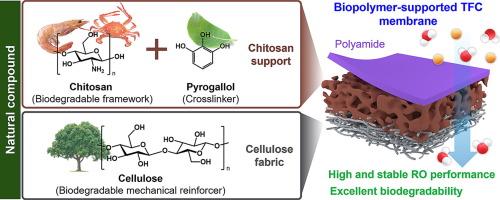反渗透用生物聚合物支撑薄膜复合膜
IF 13.2
1区 工程技术
Q1 ENGINEERING, CHEMICAL
引用次数: 0
摘要
薄膜复合膜(TFC)用于水处理,因此对环境修复工作作出了重大贡献。然而,TFC膜的底层多孔支撑膜是使用大量合成化学品和有机溶剂制造的,这对环境有不利影响。因此,开发环保型多孔膜是必要的。在这项研究中,我们通过水溶液工艺制备了一种全生物聚合物(壳聚糖(CHS)和纤维素)为基础的机械坚固的多孔膜。通过ph诱导水相分离,然后与邻苯三酚(一种源自植物的天然化合物)进行化学交联,以纤维素为基础的韩国传统纸作为衬底织物形成多孔CHS膜。所得的高孔隙度(总孔隙度 = 68.1 ± 1.9 %),机械增强的CHS膜在流体动力加压条件下比商用超滤膜具有更高的抗压性(高达15.5 bar)。制备的CHS膜随后被用作通过界面聚合制备TFC膜的载体。的CHS-supported交通膜表现出竞争反渗透性能(水浸透 = 1.68 ± 0.13 L m−2 h−1酒吧−1,氯化钠拒绝 = 99.4 ±0.1 %)和长期耐久性。CHS膜还具有良好的生物降解性,使其能够实现生态处理。我们的研究为制造各种分离应用的绿色膜提供了一个可持续的平台。本文章由计算机程序翻译,如有差异,请以英文原文为准。

Biopolymer-supported thin-film composite membranes for reverse osmosis
Thin-film composite (TFC) membranes are employed in water treatment and thus significantly contribute to environmental remediation efforts. However, the underlying porous support membrane of TFC membranes is fabricated using large amounts of synthetic chemicals and organic solvents, which can adversely affect the environment. Hence, the development of ecofriendly porous membranes is necessary. In this study, we fabricated an all-biopolymer (chitosan (CHS) and cellulose)-based, mechanically robust porous membrane via aqueous solution processes. A porous CHS membrane was formed on cellulose-based traditional Korean paper as a backing fabric through pH-induced aqueous phase separation, followed by chemical crosslinking with pyrogallol, a plant-derived natural compound. The resultant highly porous (overall porosity = 68.1 ± 1.9 %), mechanically reinforced CHS membrane had higher compaction resistance than commercial ultrafiltration membranes under hydrodynamically pressurized conditions (up to 15.5 bar). The prepared CHS membrane was subsequently used as a support for fabricating a TFC membrane via interfacial polymerization. The CHS-supported TFC membrane exhibited competitive reverse osmosis performance (water permeance = 1.68 ± 0.13 L m−2h−1 bar−1, NaCl rejection = 99.4 ± 0.1 %) and long-term durability. The CHS membrane also showed excellent biodegradability, which enabled its ecofriendly disposal. Our study provides a sustainable platform for fabricating green membranes for various separation applications.
求助全文
通过发布文献求助,成功后即可免费获取论文全文。
去求助
来源期刊

Chemical Engineering Journal
工程技术-工程:化工
CiteScore
21.70
自引率
9.30%
发文量
6781
审稿时长
2.4 months
期刊介绍:
The Chemical Engineering Journal is an international research journal that invites contributions of original and novel fundamental research. It aims to provide an international platform for presenting original fundamental research, interpretative reviews, and discussions on new developments in chemical engineering. The journal welcomes papers that describe novel theory and its practical application, as well as those that demonstrate the transfer of techniques from other disciplines. It also welcomes reports on carefully conducted experimental work that is soundly interpreted. The main focus of the journal is on original and rigorous research results that have broad significance. The Catalysis section within the Chemical Engineering Journal focuses specifically on Experimental and Theoretical studies in the fields of heterogeneous catalysis, molecular catalysis, and biocatalysis. These studies have industrial impact on various sectors such as chemicals, energy, materials, foods, healthcare, and environmental protection.
 求助内容:
求助内容: 应助结果提醒方式:
应助结果提醒方式:


